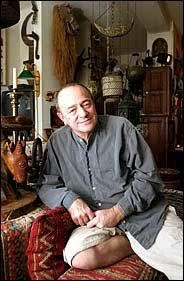
Here is a feature I did on Barton Benes almost nine years to the day. His health was bad, and he made plans to donate his intact apartment to the North Dakota Museum of Art. In the past nine years, he has continued working and creating his own wonderful relics. This year, Barton mounted an exhibit with a new gallery.
Barton Benes, The Advocate, October 15, 2002
By Dylan Foley
Visit artist Barton Lidice Benes's apartment in New York City's West Village and you may feel you're in a dream. Meticulously organized cabinets brim with macabre and mirth-inducing objects. Stuffed heads of wild animal festoon the walls, bone chips of Catholic saints hang in the kitchen, and on Benes's worktable the gallstones of actor Larry Hagman are proudly played near a straw used by Lewinsky. If what you see isn't enough, consider this: At Benes's death, this whole apartment is headed for a museum in North Dakota.
"Living in my apartment is like living in a 17th-century curio cabinet," says Benes, a 59-year-old maker of modern relics whose work has been attacked in British tabloids and featured on the cover of ARTnews. "I've been fascinated by relics ever since I took a monk's bone from the catacombs in Rome in 1963."
He's been busy. His 850-square-foot apartment is crammed with thousands of artifacts, including a statue of the Virgin Mary created by Benes from dollar bills, numerous African carvings, and a mummified Egyptian catfish that he says "smells like bouillon."
(Barton's dining room)
Benes has been HIV-positive since 1986 and suffers from emphysema This past spring, after a period of ill health, he made arrangements with the North Dakota Museum of Art in Grand Forks, whose curators will videotape, document, and measure everything to re-create his apartment in their museum on the American Great Plains.
But why is Benes donating his life's work to a museum in North Dakota? The story begins in 1993, when Benes created "Lethal Weapons," a highly controversial exhibit made up of 30 artworks filled with his own blood, including a Molotov cocktail, a water pistol, and a perfume atomizer. The show opened in Lund, Sweden, after government health officials had forced Benes to heat the artworks at a temperature of 160 degrees in a hospital oven to make them safe for public viewing. "Lethal Weapons" later toured England's Midlands as part of the group show "Brenda and Other Stories," which was attacked in the press and called "any rotten trash" by a Tory politician.
(Barton has always hated AIDS ribbons...he satired the ribbon industry with one he made out of the ashes of a friend that died. I've held one in my hand and it feels like a textured rubber mat)
"Commercial galleries in the U.S. wouldn't show it at first," says Benes, a wiry man with a wicked sense of humor. The first American viewing of "Lethal Weapons" was at the North Dakota museum, where Benes's work was exhibited without controversy. "They didn't have preconceived notions about what art should be," Benes says admiringly. "They were very open-minded with the exhibit. Even school trips came."
Benes spent his own school days in New York City, where he was raised by his Czech immigrant relatives. He was a medal-winning speed skater as a teenager but gave that up to go to art school. His lover of 30 years, the basket maker Howard Meyer, died of AIDS complications in 1989. "Most of my boyfriends are in their 20s now," he sighs. "All the good ones my age are taken."
For the past two decades, Benes has been making relics out of found and bought materials--acquiring nails from the Branch Davidian compound in Waco, Tex., and turning them into a conceptual burning cross, for example. Such images contrast nicely with Benes's Warholian "veneration" of such pop flotsam as a fork used by actor Steven Van Zandt of The Sopranos. Benes puts the "relics" into wooden cases, turning them into small "museums" that sell for as much as $20,000.
(Barton with one of his famed curio cabinets)
Now, with the future of Iris art taken care of, Benes seems headed for a rose period. His health has stabilized, and he's very active. And this October the prestigious art publisher Abrams presents Curiosa, a lavish book about Benes's bizarre collection. "I have a penny found in Sigmund Freud's couch and a piece of coal from the Titanic," says Benes of the highlights of the book. "Of course, Monica's straw will be included."
Foley writes about books for The Denver Post.

No comments:
Post a Comment